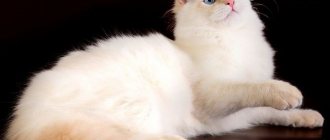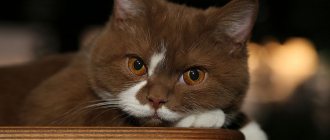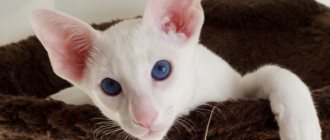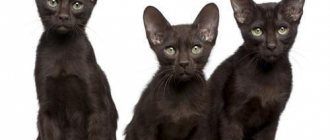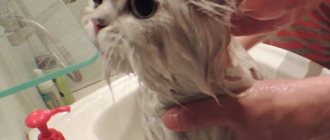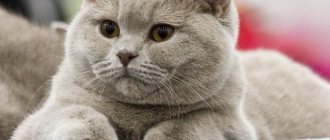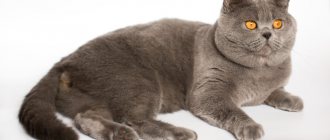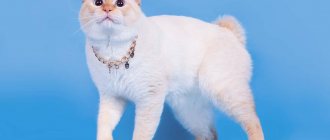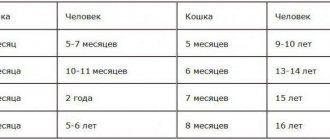Origin story
This breed has been known for a long time.
Some sources claim that short-haired cats were taken on board the ship of Christopher Columbus when he went in search of India, and then left them on the lands of the Indians. According to another version, the first ancestors of American shorthair cats were brought to the New World by English Protestants at the beginning of the 17th century. Once in a new climate, the animals were forced to adapt: their size increased, their fur became stiffer and thicker, and the health of the furry travelers became much stronger.
Add to this excellent hunting skills and we will understand why the residents of Jamestown valued these cats so highly, allowed them to live on their farms and did not interfere with their reproduction.
However, until the twentieth century, no one thought about the purity of the breed's blood and exterior, and only at the beginning of the century did breeders begin to think that it would be a good idea to stabilize the breed. The wheel of breeding began to spin: in 1904, a direct descendant of the ship's cats was registered - the dear Buster Brown, and by 1930, enthusiasts managed to breed a dozen new and original colors.
While working on the American Shorthair breed, several new breeds were created. This includes Maine Coon, Devon Rex, Ocicat, and Bengal.
CFA members created a catalog describing several dozen representatives of the breed. The old name "Domestic Shorthair" was replaced by the more characteristic "American Shorthair". Over the past 20 years, cats have risen to the top of the ranking of popular breeds and have earned recognition from such large organizations as CFF, ACFA, AACE, ACA, CCA, CFA, UFO, TICA (with the exception of FIFe - this federation still refuses to recognize it).
The photo shows an American shorthair cat in moments of rest.
The first representatives of American shorthair cats appeared in Russia in 2007. The cat Cleopatra and the cat Lucky were bought from the largest American cattery KC Dancers.
American Shorthair: history of the breed
Tabby shorthair cats have been known in the United States relatively recently, since 1965. As an independent breed, the American Shorthair was formed recently, but the history of its breeding goes back more than three hundred years. It is believed that the ancestors of these animals were wild European cats; in the final formation, the blood of Scottish cats, Bombay cats and even Maine Coons were poured into the breed.
Appearance of a wild European cat
Wild European cats were a gift from the Romans to the British people - in tenth-century England there was great trouble with the grain harvest, and the last reserves were destroyed by rodents. When Roman ships moored to the British shores, on board which were dexterous and graceful green-eyed cats, who instantly dealt with rats and mice, the British were delighted.
Wild cat from the forests of Europe
The reigning Prince Hayville at the time introduced strict laws protecting mouse cats. Thus, for the theft, injury or destruction of priceless animals, a person was subject to impressive fines. If a cat was stolen or injured due to the fault of a person, he had to hand over the sheep and lamb to the owner. If a cat was killed, the offender was obliged to give up as much grain as was guarded by the killed animal. Poor criminals paid a minimum of wheat, which was supposed to completely hide the body of a dead cat.
At the end of the tenth century, Inquisitorial times began in Europe, and green-eyed cats were destroyed along with witches, considered their main servants. They practically forgot about mousecatcher cats, since keeping such a pet could cast a “witch’s” shadow on a person.
Green-eyed cats were associated with evil spirits
The hunting abilities of wild cats were remembered in 1750, when a plague epidemic hit Pennsylvania. Animals greatly helped people by exterminating rats and mice, which are carriers of the infection. Many cats themselves died protecting their owners, but were able to stop the plague and reduce the risk of the epidemic tenfold. The surviving cats gradually recovered and, a hundred years later, again brought great benefits to people.
We are talking about the “gold rush” of 1850, when gold miners, fearful of the plague, paid fifty dollars for one cat to take it to the mines. Animals, like their ancestors a hundred years ago, destroyed rodents that carried the infection and ate people's supplies.
The ancestors of the American shorthair cat protected gold miners from the plague epidemic.
Since then, mousecatchers began to actively spread throughout Britain, from where they were brought to America - the huntresses were purchased by American gold miners, who had heard that the animals protected their English colleagues. Considering the volume of gold mining in the United States, after a couple of years the progenitors of the short-haired cat filled all the mines and gradually became the companions of ordinary people.
The breed gained extraordinary popularity, as the cats fought desperately against rodents on farms, and in the evening they came into the house and gave affection to family members. Thus, the animals gained fame not only as crop guardians, but also as gentle pets. In 1900, the American Shorthair was registered as an independent breed. 34 years later, at the largest New York felinological exhibition, the cat Mickey, representing the breed, beat out more than a thousand participants of other breeds and took second place.
The shorthair cat is the pride of America
In Russia, American shorthair cats have been known for a little over ten years - in 2007, a cat named Lucky and a cat named Cleo, purchased from the American cattery "KiC Dancers", were brought to Moscow. These animals became the founders of the breed in our country, producing a purebred litter of silver marbled kittens. Five years later, in 2012, in Russia the American Shorthair breed was already represented by five dozen cats.
Standards
American shorthair cats look quite brutal: their physique is powerful, one might even say stocky, and their muscles are strong and elastic. Males are even visually larger than females and weigh 7-8 kg, while ladies rarely gain even 5 kg.
| Standard | Description |
| Torso | With rounded and smooth lines. The chest and hindquarters are wide and developed, the back is level. If you look at the cat in profile, the slope from the top of the leg to the base of the tail becomes noticeable. |
| Paws | They look a bit short. Both the rear and the front are parallel to each other. The pads are elongated, medium-sized, high. |
| Head | The skull is almost square (a couple of millimeters are missing), the forehead is convex, the cheeks are puffy, and the cheekbones are rounded. A “stop” is clearly drawn between the muzzle and forehead. The chin is developed, with strong jaws. The neck is short and muscular. |
| Ears | Small, their tips are rounded, set wide apart (with a narrow base). Both inside and outside are covered with thick hair. |
| Eyes | Almost round, medium in size, the distance between them is equal to the length of the eye. Individuals with snow-white fur have blue or orange eyes, those with silver fur have green eyes, the general standard is orange. The color must be pure, without impurities. |
| Tail | Dense, thick, tapering towards the tip. |
| Wool | Coat: shiny, hard to the touch. With the onset of cold weather, the undercoat (already thick) becomes even thicker. |
Breed defects for which show points are deducted are:
- Frail physique;
- Neck too long or thin;
- Soft fur;
- Excessively elongated body;
- Creases on the tail, thin tail;
- Pointed ears placed too close to each other;
- Different color of the iris, blurred or pale.
Vices that lead to exclusion from competition:
- Bulging eyes;
- Lack of hearing;
- Undescended testicles;
- Undershot, overshot, jaw underdevelopment;
- Obesity or excessive thinness;
- The bridge of the nose is too prominent;
- Presence of white points;
- Limping gait, wobbling when walking;
- Fluffy coat, long hair;
- Other colors (lilac, bitter or milk chocolate, cinnamon, fawn, Burmese, Tonkinese);
- No claws.
Appearance of the American Shorthair
American shorthair cats are quite large - the body weight of an adult cat reaches eight kilograms. Cats are smaller: they usually weigh about five kilograms. Representatives of this breed have a unique difference from other cats, including outbred cats - the American Shorthair's head should be large and almost round, having equal dimensions in length and width.
Round breed animal head
Cats of this breed have a pronounced wide muzzle, neat, medium-sized ears, rounded at the tips. American Shorthairs have beautiful large wedge- or almond-shaped eyes, and the acceptable iris color is green or hazel.
The animals are athletically built, have well-developed, strong muscles - the muscles are clearly visible through the short hair. The intestines are built very proportionally: they have strong, medium-length limbs, a straight, wide muscular back, and a toned stomach. The tail is of medium length, set low, wide at the base and tapering to the tip.
The cat's physique reveals a natural-born mousecatcher
Despite the fact that cats have short hair, it is very thick, dense and has a double structure - the animals have a well-developed undercoat, which allows them not to freeze even in winter. The most popular are the marbled silver American shorthair, but the palette of colors and patterns on their coats is very diverse.
Acceptable palette of basic colors:
- blue;
- snow-white;
- black;
- smoky;
- graphite.
Graphite marble color
Table. Breed color groups
| Color group | Color options |
| Plain | Cats can have the following colors: red, cream, blue, white, black |
| Tabby | Marble color, variations: mackerel, classic, patchwork |
| Combination of two or more shades | Tortoiseshell, bicolor, spotted |
| Smoky | Solid color, as if covered with a darkened veil |
There are more than eighty variations among American Shorthair cats. More recently, in 1993, an additional color was recognized - “marble on white” (white tabby). Previously, it was believed that white cats looked “mongrel”, and for about ten years breeders have been proving that this color is characteristic of the representatives of the breed, and is not a consequence of hybridization with other breed representatives.
Peach marble pattern on white background
The colors of purebred cats also have limitations. Thus, cats whose colors show signs of crossing breeds are not allowed for exhibitions and breeding: shades of chocolate, lilac, color point (dark mask, tail and limbs on a light background).
Colors
According to the standard, the colors of this breed are regulated to a little more than 60. They are divided into several groups:
- Plain (solid) - red (red), blue, cream, black, white
- Spotted - bicolor (two colors), paticolor (with spots), tortie (tortoiseshell).
- Smoke - all solid solid colors with a slight haze.
- Tabby - mackerel, classic, marble.
The photo shows an American shorthair cat, colors: white, tabby, tricolor.
Silver merle is considered classic and animals with this color are bred in nurseries more often than others. The second place in the popularity ranking is occupied by the brown tabby.
How to choose an American Shorthair kitten?
An American purebred cat, like other animals with a pedigree, must fit into certain standards, which, in fact, distinguish it from street mongrel cats. Therefore, you need to choose and purchase a kitten from a nursery that specializes in this breed. You don’t need to believe the low price for a kitten being sold without documents on an advertisement site.
An experienced breeder will tell you about all the nuances of the breed, provide the necessary documents for the entire litter, and show the pedigrees of the parents. Actually, in the nursery you will be able to meet both parents of the kittens, or at least the mother cat. Conscientious breeders do not sell kittens while the mother is feeding them, and you can only adopt a baby that is already eating on its own.
American shorthair kittens
The cost of a kitten starts from twenty thousand rubles - for this amount you can buy a pet that has all the qualities of the breed. If it is assumed that the pet will not only please the owner, but also participate in exhibitions with the prospect of further breeding, the price will approximately double - show kittens can cost from 50 thousand rubles and more.
Despite their enormous popularity in their homeland, the USA, American Shorthairs are just beginning to win the hearts of cat lovers around the world. There are not many representatives of this breed in Russia, but a person who decides to adopt a rare kitten will not regret it. American Shorthair cats are smart, gentle and unobtrusive, and communication with them brings a lot of positive emotions.
Character and behavior
If animals could be divided according to zodiac signs, then the American Shorthair would be a typical Libra. They do not rush from one extreme to another, but maintain a balance in everything: in games, sleep, communication with the owner, friendship with other cats and dogs. They don’t mind playing, but you can’t call them restless, they are tolerant, but do not allow disrespect for their person, they love to communicate, but prefer not to intrude.
They are not talkative, but not silent either: if the “American” wants to talk or needs something, you will hear a quiet “meow” and feel how they delicately touch your leg with a paw. This cat definitely won’t start roulades in the back room; shouting is beneath her dignity.
“Americans” are affectionate: they patiently wait for their owners, sitting on the rug by the door, but they will not jump for joy and lick your hands. By the way, cats of this breed do not particularly like to sit on your hands, and, paying tribute to politeness, they directly make it clear that it is better to let them down.
The hunting instinct of the “Americans” is well developed. Even in an apartment, they will “give” a fight to both small midges and a butterfly that accidentally flies into the light of a lamp, and they know how to save household members from annoying mosquitoes better than any “Raptor”. If you live in a private house and from time to time you let your cat out into the yard for a walk, expect a gift in the form of a strangled sparrow or mouse. Do not scold your furry pet, but rather praise him: after all, he tried for you.
It is precisely because of the love of hunting that you should not bring rodents and birds together with your American Shorthair cat: neither cages nor constipation will save them. But “Americans” get along quite well with cats of other breeds and even dogs. Friendships rarely develop (“Americans” are quite independent people), but they definitely won’t fight for territory or attention.
They treat children condescendingly, as if I understand that one cannot expect prudence or accuracy from a little fool. “Americans” will not allow themselves to let out their claws or bite, but they will try to hide somewhere higher at the slightest attempt by your child to pull the cat’s tail.
These are smart and smart cats, but training is not their strong point. More precisely, not yours, and the “American” will show it to you with all his appearance. Of course, you can try, but only at an early age, come up with effective motivation and do not let the kitten get bored or very tired during exercise.
Character
American Shorthair cats have a pleasant personality and are comfortable in many ways. Several centuries of living in harsh natural conditions have made her independent and independent, but at the same time she is sociable and friendly with people she knows well. She quickly adapts to the rhythm of family life and is quite smart. She does not like excessive attention and behaves unobtrusively.
American Shorthair kittens are very active and energetic, but adult animals also retain the need for games and have a passion for heights, jumping and hunting. They prefer to sit on the tops of trees, and in the house on cabinets, bookshelves and other high-altitude places where they can observe their entire territory. If your cat has access to the outdoors, she will certainly enjoy catching small rodents, birds and insects.
American Shorthairs are not “talkative” and demanding cats; they always have something to say and talk about. Very often requests begin with a quiet “meow.”
Care instructions
Unlike their long-haired counterparts, short-haired “Americans” give owners a little less trouble. But you still can’t get away from caring for them. You want your cat to look good, right? Then remember!
Wool
The “American” should be combed once a week, using a rubberized brush or a silicone-coated glove. During the molting period, the procedure will have to be repeated every day, and at the end, you will have to stroke the cat several times with wet hands to collect the remnants of fallen fur.
Bathing
The water of these cats is more likely to irritate than to please: it makes noise, gets into the nose and ears, and the list goes on. Therefore, do not waste your nerves and bathe the “American” only in case of urgent need: on the eve of the competition or if your pet has fallen from head to toe in a dirty puddle. In all other cases, he will do a great job with his tongue. As a last resort, you can use special wet wipes without alcohol and aromatic fragrances. And remember: no drafts in the room where the American Shorthair lives! This breed has weak nose and ears.
Does your cat like to swim?
Not really
Eyes
The eyes of “Americans” rarely run, so you should only examine them from time to time. If crusts appear in the corners of the eyes, remove them with a damp cotton pad. If pus appears from the lacrimal canal or redness of the cornea, the cat should be shown to a doctor!
Ears
The ears are wiped every week: a cotton pad is moistened with ear lotion (for example, VEDA) or a warm decoction of chamomile, and wax and dirt are removed from the skin. Do this carefully, without pouring liquid into the ears, otherwise the cat will develop otitis media.
Claws
“Americans” grind their claws well on their own, but you are required to buy a stronger and larger scratching post. Otherwise, the pet will choose a more comfortable sofa or a nice piece of wall for these purposes.
Teeth
The last point is teeth. The teeth and gums of “Americans” are often the weakest point. Therefore, try to accustom your cat to brushing its teeth from childhood. Be persistent, but patient and careful, use only special products: cat paste and a special toothbrush.
Expert opinion
Dusheba Vera Ivanovna
In 2010, she graduated from the Moscow State Academy of Veterinary Medicine named after K.I. Scriabin with honors, specializing in veterinary medicine. I regularly attend veterinary conferences, congresses, and webinars.
All necessary supplies for brushing teeth can be purchased at any pet store. A toothbrush can be silicone or a regular one, similar in appearance to a child’s one, but smaller in size (by the way, you can use a child’s one as a last resort - just trim the bristles on it). Paste: Levrana, Trixie, something else - the main thing is to choose a product without fluoride, with a pleasant taste of mint or meat. For aggressive or very shy cats, cleaning drops have been developed that are added to drinking water, as well as chewing sticks, pads and sprays.
Pictured are American Shorthair kittens
Care and maintenance
The American Shorthair has absolutely no fear of water; on the contrary, it loves to swim, and is also an excellent swimmer. This applies not only to adults, but also to teenagers and very young kittens.
Compared to long-haired cat breeds, “Americans” do not need careful care for their charming fur coat. It is enough for them to comb their fur weekly using a rubber brush or gloves with silicone growths. During seasonal shedding, you need to repeat the procedure every day to keep your pet looking neat. American Shorthair cats do not like to take baths and are also quite clean, so refrain from frequent bathing. You can use a damp piece of cloth to wipe away small dust particles. A piece of suede will help to apply a healthy and pleasing shine to the fur.
If your pet does get dirty, bathe it with pet shampoo for short-haired breeds. After a cat bath, make sure that your pet is not in a draft: this can lead to colds even for such a strong and healthy breed.
Once every two to three weeks, pay attention to the animal’s eyes and ears. Remove foreign particles using a damp cotton pad. If your cat regularly walks outside, check it daily to prevent possible infections.
Important: if discharge from the eyes and ears has a specific color or smell, contact your veterinary clinic for advice.
It is equally important to take care of the “combat arsenal” of the American Shorthair cat – teeth and claws. In the first case, the rules are quite simple: plaque is removed using a paste. Do not use your own hygiene product: it foams a lot and has a minty taste that is harsh for the animal. An old brush or a finger attachment is suitable as a tool. For preventive teeth cleaning, special hard treats are often used.
Cats should not be overfed, otherwise overeating combined with the habit of pampering can lead to obesity.
Shorten the American's claws using a nail clipper. It wouldn't be a bad idea to buy a scratching post. It will help keep the interior of the apartment intact. Teaching a kitten to sharpen its claws in a certain place is not a problem; it is more difficult to prohibit this for an already matured animal.
There is one important nuance in feeding an American Shorthair cat. Representatives of this breed have an excessive appetite and are ready to absorb all food within a radius of several meters. You will have to strictly control the portion size and not react to the pleading look of your pet. It is recommended to weigh your cat every week and adjust its diet depending on its weight. If your graceful pet is becoming more and more like a clumsy ball, pay attention to active games. Obesity in American Shorthair cats leads to problems with the cardiovascular system.
Nutrition should be structured in such a way that the animal receives the required amount of vitamins and microelements along with food. The best option is premium balanced dry food. If you decide to stick to a natural diet, use a vitamin-mineral complex as an aid. This will help your pet maintain excellent health.
The American Shorthair cat is not eager to go for a walk, but if the owner still decides to allow them to roam freely, they can easily bring a mouse - the hunter's instinct will work.
Do not include in your American Shorthair cat's diet:
- lamb and pork (due to high fat content);
- fried, pickled, sweet and salty foods;
- “human” drinks – coffee and tea;
- milk (not relevant for kittens);
- river fish in any form;
- legumes;
- tubular bones;
- onion and garlic;
- dried fruits;
- potato;
- mushrooms.
In a separate bowl there should be filtered water - bottled or infused for 6-8 hours. It is not recommended to give your animal boiled water. Its frequent use entails urolithiasis.
Catering
This breed has one peculiarity: its representatives are very gluttonous. They can rattle the bowl for a long time and expressively if they think that the portion was too small, and will not disdain to climb into the trash can to look for more. If you don’t want your Barsik to turn into a round and short-breathing bun, set strict feeding rules.
- Adult cats (over six months old) eat 2 times a day (indulgence is made for lactating females, pregnant women and animals that are sick, weakened, or very old). Kittens 4-6 months old are fed 3-4 times a day, babies - 5-6. In other cases, be firm and do not feed the animal outside of normal hours.
- Food should be balanced, rich in minerals and vitamins, contain taurine, amino acids, and plenty of proteins, fats and carbohydrates.
- You cannot mix natural food and ready-made food, but it is allowed to feed alternately wet and dry food from the same line.
The animal should always have access to clean water that is comfortable for drinking. Change it morning and evening.
Natural products
When choosing natural food, try to buy fresh, high-quality products. The diet should include:
- Lean raw meat (veal, rabbit, turkey, beef).
- Sea fish (flounder, hake, trout).
- Stewed vegetables (pumpkin, zucchini, carrots, greens, asparagus, beans).
- Porridge with water (rice, buckwheat, oatmeal).
- Dairy products (yogurt, cottage cheese, fermented baked milk, unsalted hard cheese).
- Boiled eggs (quail and chicken yolk).
- Grow wheat and oats for the “American” so that he can use them to cleanse his stomach.
But fatty meat, lard, flour, smoked, sweet, spices, human drinks and canned food cannot be fed to cats.
Recommended food
When choosing ready-made food, keep in mind that the cheaper the food, the worse it is. Don’t let the bright packaging fool you; economy-class cat food will fill you up, but won’t bring you any benefit. The raw materials used for their production are of the lowest quality; there are a minimum of vitamins, but there are plenty of flavor enhancers and preservatives. Such foods provoke problems with the gastrointestinal tract, obesity, diabetes, urolithiasis and a lot of other ailments.
The same can be said about premium food. They are more expensive, but instead of meat they use bones, hooves and feathers, vegetable protein (which is often an allergen), and the same taste enhancers (monosodium glutamate), which are addictive.
Super-premium and holistic foods are significantly more expensive, but their composition is strikingly different: fresh and dehydrated meat, fish fillets, dried vegetables and berries, healthy additives, antioxidants, natural preservatives.
Wet food is even more expensive and is suitable for cats that do not like to drink a lot, as well as those with certain ailments (urolithiasis, tartar).
Holistic foods include Acana and Carnilove. Super-premium: Bozita, Dr. Сlauder's, Summit.
Below are the recommended holistic and super-premium foods. Links with the names of the food are clickable, on them you can, within our website, get acquainted with the descriptions of the food and read reviews from owners of American Shorthair cats.
| Holistic | Super premium | Super premium |
| AATU | Arden Grange | Vet Life |
Diseases
This breed does not suffer from genetic pathologies, but improper care can cause some difficulties. For example, if you give a cat a bath and open the window in the room where he is sitting, he will catch a cold, start sneezing and coughing. If you don’t brush his teeth, he will develop gingivitis, and persistent overfeeding will lead to excess weight and heart problems.
And don't forget about vaccinations. The causative agents of many diseases are very tenacious, and they can easily be brought home on the sole of a shoe, on a toy or a bag. Your veterinarian will advise you on the vaccination schedule.
Expert opinion
Dusheba Vera Ivanovna
In 2010, she graduated from the Moscow State Academy of Veterinary Medicine named after K.I. Scriabin with honors, specializing in veterinary medicine. I regularly attend veterinary conferences, congresses, and webinars.
If you want to buy an American shorthair kitten, go not to the bird market, but to a nursery or a private breeder. Be sure to read the documents, look at the baby’s parents, and talk for a few minutes with the baby himself. You can adopt a kitten at 3 months, when its immunity is stronger and its mother accustoms it to the litter box and eating on its own. The cost of an elite kitten varies between 20-30 thousand. If you do not plan to transport the animal to exhibitions, the price tag will drop to 10-15 thousand.
Homeland:
USA
Origin:
1860s
Breed recognized:
ACF, WCF, GCCF, FIFE, CFA, TICA, ACFA.
Group:
longhair
Type of color:
solid, smoke, shaded, tabby, bicolor
Color color:
black, red, blue, cream, white Maine Coons are strong, stocky, robust cats with long hair, especially long on the back, belly and hind legs .
Maine Coons are the largest cats, their weight can reach 18 kg. Ears: large, erect, set high, with pointed tips. Eyes: medium size, round, slightly slanted, with a golden or greenish iris. Muzzle: Large, square-shaped, slightly wider than tall. Neck: not long, thick, strong. Body: medium size, muscular, strong. Coat: long, shiny, heavy. Legs: medium length and thickness, muscular. Feet: Compact, medium-sized, rounded. Tail: Long, tapering to a tip, with wavy hair. The breed traces its origins to country cats that arrived in America with the first settlers. It is assumed that the ancestors of the Maine Coon include British Shorthair, Scandinavian and Russian Longhair cats, as well as, possibly, cats from the East. Over the years of natural selection, Maine Coons have acquired thick, dense hair and large sizes necessary for survival in harsh climates and hunting. The name of the breed translates as “Maine raccoon,” but these cats have nothing to do with raccoons, resembling them only in color. The first Maine Coon is considered to be a cat shown at an exhibition in New York in 1861. At the beginning of the 20th century, the popularity of the breed fell and was revived only in the 1950s. The breed standard was officially registered by the CFA in 1976. With the advent of the new millennium, the Maine Coon became the second most popular cat in the United States. The breed is recognized in all countries, but the British standard is somewhat different from the American one. British cats have a rounder muzzle, oval eyes, and medium-sized ears. Features and character:
active, good-natured, self-confident, but reserved;
gentle and affectionate with their owners, unobtrusive, gets along well with children; they are loyal to strangers, but do not tolerate familiarity; have a pleasant voice and a characteristic soft purr; are able to remember many words and intonations and understand a person well; must have their own space where they can be left to themselves and have sufficient territory for walking; good hunters. Recommended:
for any family.
Other names of the breed:
Maine;
Maine (or American) shaggy; American raccoon; American (forest) long-haired; Snaghead; Yankee cat. Breeds created with the participation of the Maine Coon:
American Forest Shorthair - a variant of the Maine Coon with short hair;
Maine Coon Rex - a hybrid of Maine Coon and Cornish Rex or German Rex; renegade - a hybrid of a Maine Coon and a Bengal cat, an attempt to breed the largest cat in the world; Si-coon is a hybrid of a Siamese cat and a Maine Coon. *** Maine Coon is a source of pride for Americans.
And they can be understood. This is a magnificent breed of cat. The well-built, well-built Maine Coon with its lynx ears and tail, reminiscent of a curved Turkish sword, exudes the unlost healthy freshness of the wild. He remained the way she created him. Before this miracle, which is an amazing balance of proportions and forms, a person feels only admiration. It never occurred to anyone to change anything about this breed. And it’s very good that it didn’t come. It is a sin to perfect perfection itself.
Maine Coon is one of the oldest breeds in North America. A powerful cat with hair that is not short, but not very long, appeared in the homes of American settlers in the middle of the last century, first in the northeastern United States. In May's rather harsh winter, short-haired animals would not be able to survive at all. And if you pay attention to the soft warm fur on the paws, which prevents them from freezing in the snow, to the warm fluff that protects the ears from frost, it will become clear that this is still a child of local nature.
Remarkable hunters, Maine Coons were able to stop the proliferation of mice in the rapidly growing grain farms of New England. But soon they announced themselves in a completely different role. The Maine Coon became the first purely American breed to appear at cat shows around the world.
Maine Coon. History in legends. If you listen to what they say in the northeastern regions of the United States, these stories can be combined into three legends that explain the origin of the Maine Coon.
The legend is fantastic. The first settlers who discovered and domesticated Maine Coons believed that they were the result of a love affair between a common European cat and a raccoon. The English word for raccoon does contain the word "coon". This is where the “Maine (from Maine) raccoon” came from - the Maine Coon.
Romantic legend. The ancestors of Maine Coons were cats that lived in the chambers of the French queen Marie Antoinette. During the French Revolution, the queen decided to flee to America. She handed over her most priceless things, including cats, to a certain captain Samuel Clue, with whom she was secretly in love. The captain, originally from the town of Wiscasset in Maine, delivered the queen's treasures there. The royal cats made friends with the locals and, without knowing it, founded a new breed - the Maine Coon.
The legend is mysterious. In ancient times, a captain named Coon sailed along the coast of New England on his ship. In his cabin there lived a cat and a male cat, a Persian and an Angora. When the ship dropped anchor and the crew went ashore, the captain let his pets out for a walk. Everywhere Kun's ship visited, kittens were born over time. So all that remains is to take off your hat and say: “Thank you, Captain Kuhn!”
The end of legends - the beginning of history. Exhibitions. Since 1860, at exhibitions held in the northeastern regions of the United States, all prizes were shared among the most beautiful representatives of this breed. And in 1895, wider recognition came: at the main American exhibition in Madison Square Garden, the title “Best Cat” went to a Maine Coon named Cozy.
Despite the rapid initial success, in subsequent years Maine Coons were almost consigned to oblivion, since at the beginning of the century imported cats, in particular Persian cats, became fashionable in America.
The return came only in 1953, when the Central Maine Coon Fans Club was created in the USA. In 1968, the Maine Coon Fanciers Association was created in the USA. These two clubs did a great job of popularizing the breed and setting its standards. In 1976, more than a hundred years after their first appearance at exhibitions, Maine Coons were officially recognized as having the right to participate in competitions and exhibitions in North America. American cat lovers were very happy with this decision; it certainly touched the heartstrings of their national pride.
The ruling council of cat lovers, whose headquarters is in London, officially recognized the Maine Coon only on February 24, 1988.
In France, the spread of this breed began in 1981, when the first cat named Charlie was imported from Germany. Since then, the Maine Coon has steadily found more and more admirers in France. These are mainly young people who join the fighters for the protection of nature. One is attracted by both the natural aspect of this animal and its gentle and kind disposition.
Having a powerful physique, Maine Coons are essentially hefty, good-natured people. They will not harm either the dog or the child. And they are easy to train, especially from an early age. Without being aggressive, they, to a certain extent, to a point that does not affect their dignity, allow themselves to be caressed and squeezed. In short, we can say that this breed is distinguished by intelligent behavior both in relation to the people around them and to animals.
They become very attached to humans and are able to follow their owner “step by step.” For the owner, the Maine Coon has its own unique call; it knows how to call, modulating its voice in a special way.
His shortcomings? He still retained his natural wariness. As soon as you open the door unexpectedly, the Maine Coon in the room instantly “flies up” onto the closet. Another drawback: even if he does not use his claws when communicating with people, he is not averse to scratching wallpaper and especially upholstered furniture. However, it is not difficult to wean him from a bad habit. It is enough to place a specially made board covered with fabric somewhere in the corner of the apartment and make it clear that he can only scratch it; the Maine Coon, distinguished by its understanding and rare ability for cats to obey human demands, will stick its claws only into this board.
The Maine Coon does not require special care. A wide-tooth comb is a common tool for occasionally tidying up his coat. It is not recommended to bathe him often, but it is necessary to do so before participating in the exhibition. Experts bathe them 8 days before participating in the show so that the coat has time to take on its beautiful natural appearance.
Being a large animal, the Maine Coon gains full strength only by the age of four or five years. In order for bones to form properly, kittens need to be given calcium supplements in their food. The normal weight of an adult cat is 6-9 kilograms, a female cat is 4-6 kilograms. The weight of a Maine Coon can reach 18 kilograms!
The peculiarity of cats is that the gestation period lasts not 65 days, as usual, but 68 days. A strongly built mother gives birth without difficulty and surrounds her children with exemplary love and affection (from one to six of them are born, and they come in a wide variety of colors).
Without any special features, but elegant, with good coat and at the same time not requiring special care, with a wild appearance, but gentle, like a bear cub, the Maine Coon has all the qualities to be loved.
